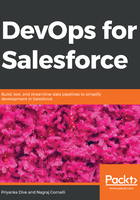
Applying DevOps to Salesforce Applications
In the previous chapter, we learned some basics about the Salesforce development process, what a sandbox is, the different types of sandbox, and how to choose a sandbox according to our needs. We developed our own recruiting application using Salesforce, followed by learning the traditional ways used for Salesforce deployment. We also had a look at the issues we face during traditional deployments of Salesforce applications. We learned Salesforce development setup with Eclipse. We discussed applying DevOps to Salesforce applications.
In this chapter, we will discuss why there is a need for DevOps in Salesforce applications. We will also discuss the problems we face while working on big projects that involve large numbers of developers, testers, and so on. We will try to get a clear idea about how applying DevOps for Salesforce is different from other tech stacks such as simple Java application stacks. We will differentiate between the development process involved in Salesforce applications and that of other tech stacks such as Java, PHP, Ruby, and so on. We will also see in detail the DevOps process in Java applications to get a clearer idea about the DevOps continuous integration and delivery process using DevOps tools. We will go through a step-by-step process to set up a simple continuous integration pipeline with Jenkins and Git. We will also learn how to install required plugins, configure the Maven plugin in Jenkins, and how to add a Jenkins webhook URL in a GitHub project; we'll also implement continuous deployment using the Jenkins plugin. Finally, we will see how we can deploy our code whenever any changes are pushed to GitHub.
In this chapter, we will learn about the following topics:
- The need for a DevOps process in Salesforce development.
- The differences between DevOps for Salesforce and DevOps for other tech stacks. For example, the typical DevOps process for a Java development stack